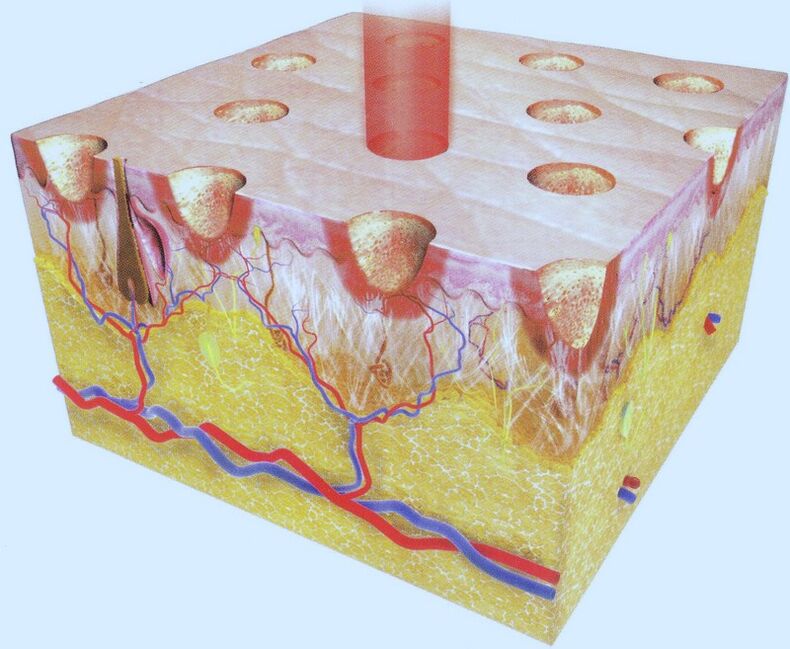
In modern medicine, a large number of hardware techniques and non-hardware processes are now used to solve the problems of young and aging skin, but you should not confuse the youthfulphoto and elos with fractional rejuvenation - fractional pyrolysis.
Fractional pyrolysis is a controlled, effective and safe rejuvenation method that removes various cosmetic defects using lasers, suitable for both aging and youthful skin. During the operation, a laser beam is formed as thick as a human hair. For a light beam measuring 1-1. 5 square centimeters, the laser "pierces" a lot of microscopic wounds (microscopic laser incisions) in the skin. Around each of them, unaffected areas remain, and the damage caused by the laser pulse creates an impetus to restore skin structure over the entire treated surface.
Consider the technology itself. "Segmentation" abolition (ablation) rejuvenation closely interacts with "traditional" where fractional (ablation) rejuvenation, due to its "spot" radiation, produces areas of microthermal injury(MTZ), intercalated with untreated tissues. As a result, healing is much faster (only 1-2 days), allowing you to immediately return to your normal lifestyle.
The job of the laser is to destroy microscopic parts of old collagen and elastin, and at the same time the preserved cells around the affected area "wake up" and begin to regenerate the damaged area. Regenerated collagen and elastin, as well as other proteins coagulated by laser in the affected area, are involved in tissue regeneration. A new, functional skin with all the properties of a youthful skin is formed.
The therapeutic effect is determined by the location of the microscopic areas on the skin.
Areas of contact: face (including upper and lower eyelids, crow's feet), forehead, eyebrow area, temple area, cheeks, nose, triangle of nose, chin, neck, buttocks, hands, lower legsarms, mammary glands, abdomen, back, thighs, buttocks and other areas.
Fractional pyrolysis allows:
- achieve a rejuvenating effect on the skin of the face, neck, pubic, back of the hands;
- remove wrinkles in the sensitive and delicate areas of the eyes ("crow's feet");
- removal of age spots (hyperpigmentation, melasma);
- significantly smooth, to complete disappearance, postoperative and traumatic scars (after cuts and burns);
- anti stretch marks;
- corrects the effects of acne (post-acne);
- reduced skin tone;
- an alternative to deep chemical peels.

How does the procedure work? Before starting treatment, the skin is cleaned with an antiseptic. The doctor establishes the necessary parameters in each specific case for the operation of the laser.
Fractional pyrolysis is performed directly with the help of a special accessory, which allows to maintain the same distance from the "starting point" of the light beam to the skin.
During the session, the "light" of the laser gives you a sensation equivalent to a tingling sensation. The procedure ends with the application of a moisturizing cream that soothes the skin.
The duration of the session and the number of procedures depend on the size of the treated area and the problem being addressed.
After the procedure, rehabilitation time is minimal. The rapid re-epithelialization ensures restoration of the epidermal barrier, reduced erythema and immediate clinical results (tissue "tightens" due to selective parameters of thermal radiation). Tissue reactions in the form of mild edema and redness of the skin persist for one to two days. The natural flaking following this procedure is eliminated with a mild exfoliator and moisturizer.
For uncomplicated recovery and lasting results, you need to follow all of your doctor's instructions for caring for delicate skin at home!
Contraindications for fractional pyrolysis
- Pregnancy.
- Epilepsy.
- Cancers.
- Acute inflammatory skin diseases.
- Herpes in the active phase;
- Psoriasis.
- Atopic dermatitis in the acute stage.
- Inflammatory processes in the proposed treatment area.
- If less than 2 weeks after chemical peels and similar procedures.
- If less than 2 weeks have passed since the last tanning.


























